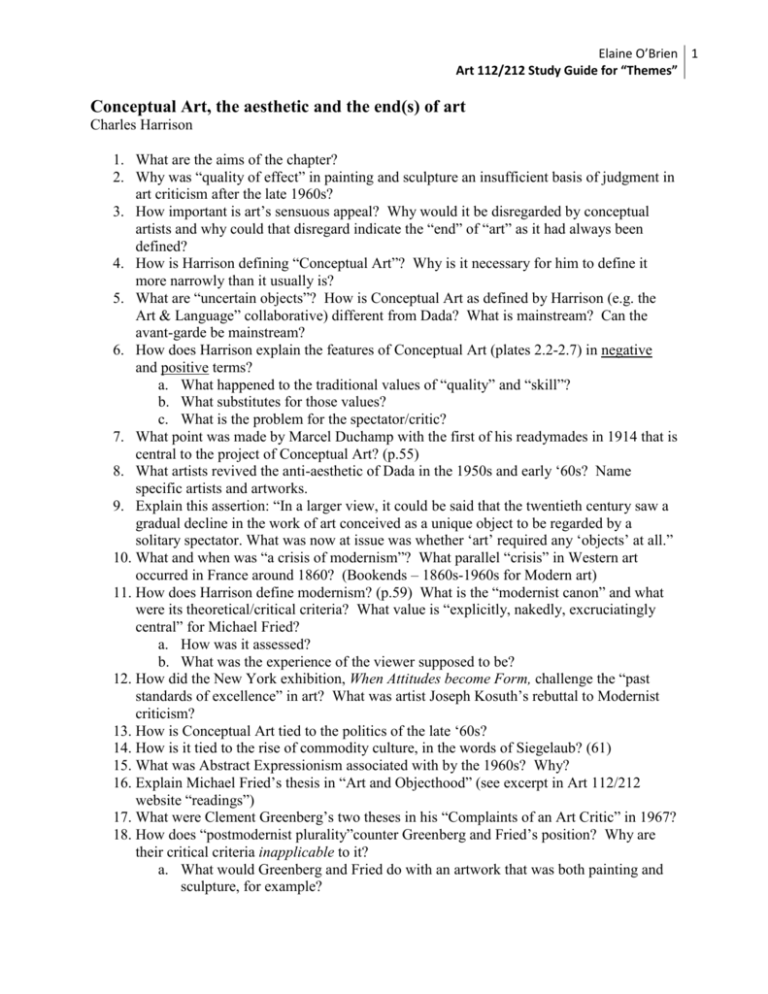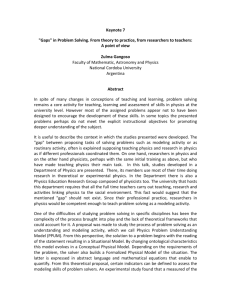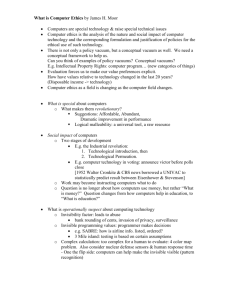Art 112/212 Study Guide for “Themes”
advertisement

Elaine O’Brien 1 Art 112/212 Study Guide for “Themes” Conceptual Art, the aesthetic and the end(s) of art Charles Harrison 1. What are the aims of the chapter? 2. Why was “quality of effect” in painting and sculpture an insufficient basis of judgment in art criticism after the late 1960s? 3. How important is art’s sensuous appeal? Why would it be disregarded by conceptual artists and why could that disregard indicate the “end” of “art” as it had always been defined? 4. How is Harrison defining “Conceptual Art”? Why is it necessary for him to define it more narrowly than it usually is? 5. What are “uncertain objects”? How is Conceptual Art as defined by Harrison (e.g. the Art & Language” collaborative) different from Dada? What is mainstream? Can the avant-garde be mainstream? 6. How does Harrison explain the features of Conceptual Art (plates 2.2-2.7) in negative and positive terms? a. What happened to the traditional values of “quality” and “skill”? b. What substitutes for those values? c. What is the problem for the spectator/critic? 7. What point was made by Marcel Duchamp with the first of his readymades in 1914 that is central to the project of Conceptual Art? (p.55) 8. What artists revived the anti-aesthetic of Dada in the 1950s and early ‘60s? Name specific artists and artworks. 9. Explain this assertion: “In a larger view, it could be said that the twentieth century saw a gradual decline in the work of art conceived as a unique object to be regarded by a solitary spectator. What was now at issue was whether ‘art’ required any ‘objects’ at all.” 10. What and when was “a crisis of modernism”? What parallel “crisis” in Western art occurred in France around 1860? (Bookends – 1860s-1960s for Modern art) 11. How does Harrison define modernism? (p.59) What is the “modernist canon” and what were its theoretical/critical criteria? What value is “explicitly, nakedly, excruciatingly central” for Michael Fried? a. How was it assessed? b. What was the experience of the viewer supposed to be? 12. How did the New York exhibition, When Attitudes become Form, challenge the “past standards of excellence” in art? What was artist Joseph Kosuth’s rebuttal to Modernist criticism? 13. How is Conceptual Art tied to the politics of the late ‘60s? 14. How is it tied to the rise of commodity culture, in the words of Siegelaub? (61) 15. What was Abstract Expressionism associated with by the 1960s? Why? 16. Explain Michael Fried’s thesis in “Art and Objecthood” (see excerpt in Art 112/212 website “readings”) 17. What were Clement Greenberg’s two theses in his “Complaints of an Art Critic” in 1967? 18. How does “postmodernist plurality”counter Greenberg and Fried’s position? Why are their critical criteria inapplicable to it? a. What would Greenberg and Fried do with an artwork that was both painting and sculpture, for example? Elaine O’Brien 2 Art 112/212 Study Guide for “Themes” 19. What was “the moment of ‘postmodernism’”? 20. Why is it important to be careful about making hard distinctions between modernism and postmodernism? a. Did the Modernist accounts of Greenberg and Fried adequately describe the practice of Modern art from 1860s-1960s? 21. How did the theories of Jasper Johns counter the limitations of Modernist criticism and how did his ideas affect his art making? 22. How did philosopher Arthur Danto support “the strategy of putting the talk up on the wall”? What artist/artworks inspired his theories? Why? a. Explain Danto’s idea: “To see something as art requires something the eye cannot descry- an atmosphere of artistic theory, a knowledge of the history of art: an artworld.” 23. Why did Danto say that “art” came to an end with Pop? 24. What critical criteria have come to replace those of Modernist criticism? 25. Who has co-opted the value of “quality” for judging works of art? 26. What did Kosuth mean that there is a shift from “perceptual” to “conceptual” in Conceptual Art of the Art & Language group? 27. What is the difference between an “autographic work and the “allographic” arts, according to Nelson Goodman? 28. Did the Conceptual Artists’ desire to avoid the commercialization of artistic practice succeed? Has the art market managed to profit from Conceptual Art? How have they managed to make the art “autographic”? 29. How did Hegel define the “end of art”? When and why did he say it occurred? 30. How would you practice “objective humor” in looking at and evaluating the worth of artworks? (pp.76-77) 31. Has the value of the “autographic” faded in art teaching? 32. Do you think that Art & Language was a reductio ad absurdum, a transitional episode that re-introduced intellect and politics into art practice? 33. How did Conceptual Art develop in the medium of painting?





